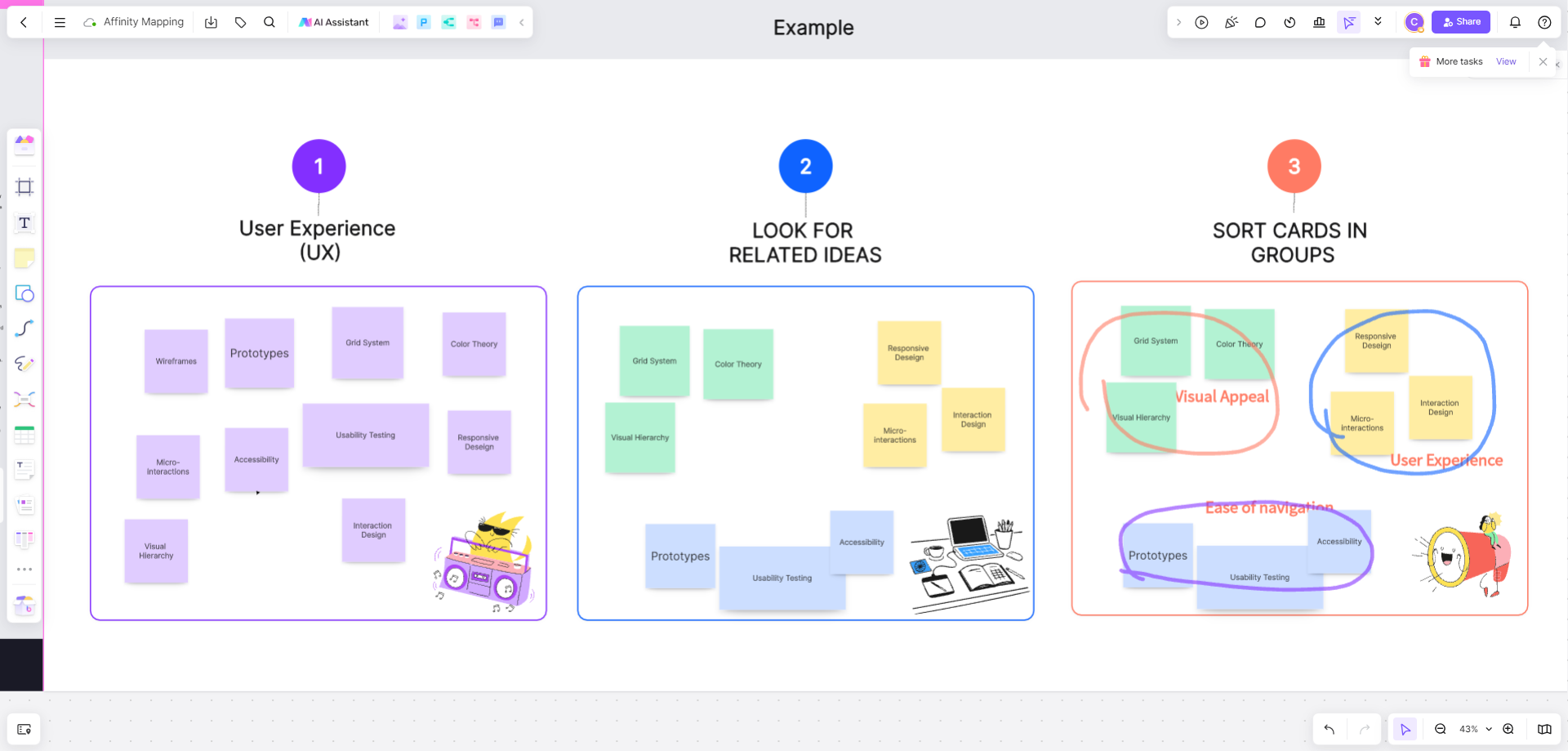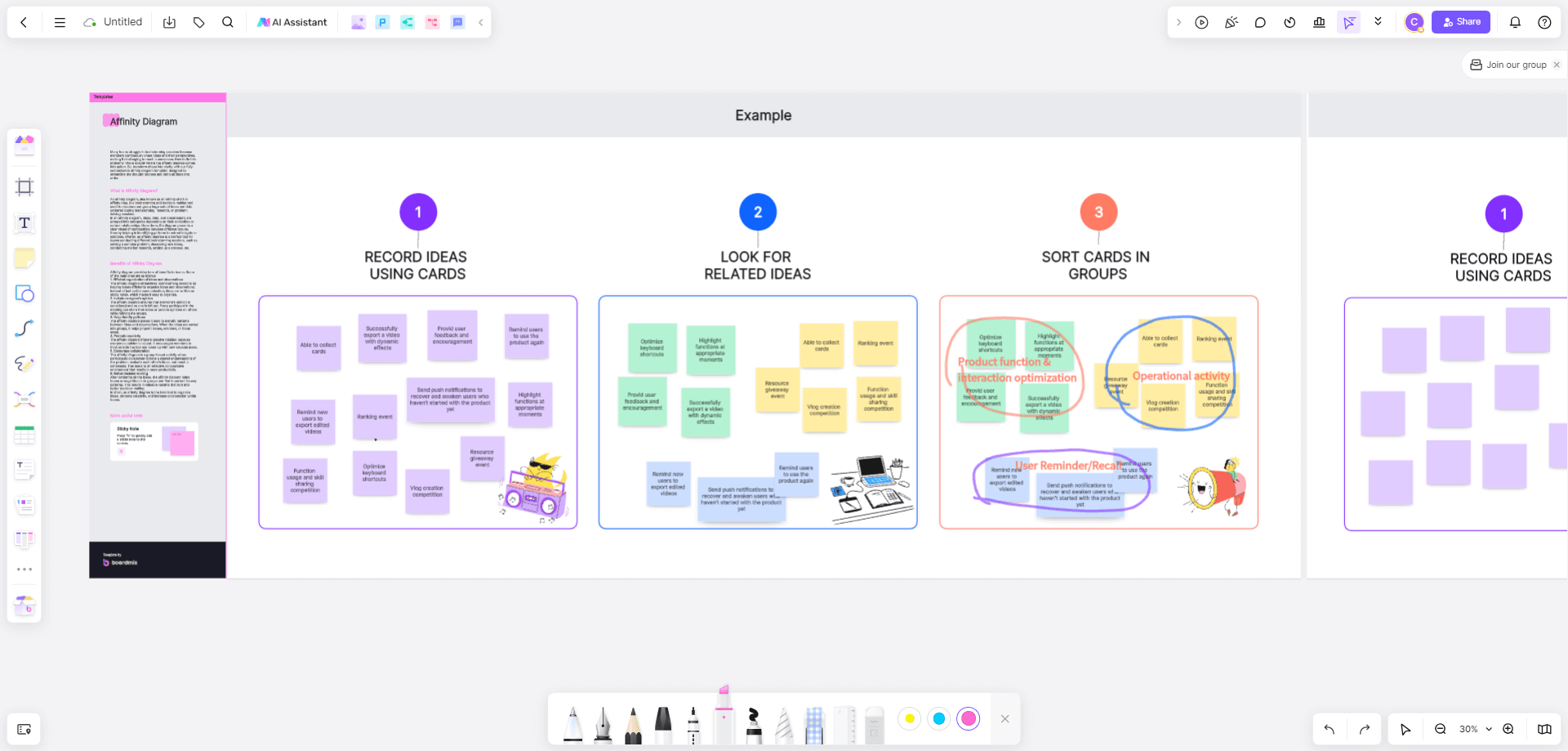Our modern age has blessed us with the magic of the internet and the endless possibilities it holds. One of these possibilities is the transformation of traditional brainstorming into a digital realm, using tools like Boardmix. At the heart of Boardmix lies the concept of Affinity Mapping, a game-changing technique that will redefine the way you complete delicate Affinity Mapping with collaboration and innovation.
1. Unveiling Affinity Mapping
At its core, Affinity Mapping is a collaborative activity where a group's ideas and thoughts are visually sorted and grouped according to their relationships or themes. In a sea of scattered ideas, Affinity Mapping acts as the lighthouse guiding the ideas towards structured shores. By clustering ideas, team members gain new perspectives and often discover hidden insights and patterns. These could be the catalyst for innovative solutions that may have been overlooked in individual brainstorming sessions.
The power of Affinity Mapping extends beyond merely sorting ideas. It encourages full participation from team members, brings clarity to complex problems, fosters improved understanding among teammates, and significantly decreases conflict by providing an unbiased view of ideas. Moreover, it provides a visual narrative that allows all participants to view and comprehend the collective thoughts of their team.
2. Advantages of Using Affinity Mapping
- Facilitates Teamwork: Affinity Mapping encourages all members to contribute, thereby promoting team collaboration and unity.
- Encourages Diversity of Thought: This process welcomes ideas from all perspectives, fostering a rich pool of diverse insights.
- Visual Organization of Ideas: By visually structuring ideas, Affinity Mapping allows for easier comprehension and interpretation, especially when handling large data sets.
- Aids in Problem Identification and Resolution: By identifying patterns and relationships between ideas, Affinity Mapping can aid in problem-solving and strategic decision-making.
- Promotes Engagement: As a participatory process, Affinity Mapping keeps team members engaged and invested in the project.
- Supports Conflict Management: By encouraging open dialogue and exchange of ideas, Affinity Mapping can help manage disagreements in a structured and constructive manner.
- Fosters Creativity and Innovation: The brainstorming and categorization involved in Affinity Mapping can spur creativity, leading to innovative solutions.
Remember that the effectiveness of Affinity Mapping can greatly depend on its facilitation, so ensure that all participants are comfortable sharing their thoughts and ideas.
3. Guidelines for Successful Affinity Mapping
Like any other method, effective Affinity Mapping requires careful navigation. Here are some guidelines to ensure a smooth sailing journey.
- Open-mindedness is paramount. Embrace the diverse thoughts brought to the table and resist the urge to dismiss ideas based on personal bias. Affinity Mapping thrives on diversity – the more varied the ideas, the richer the solution.
- Transparency is vital – encourage members to elaborate on their ideas for a comprehensive understanding. Also, promoting active listening ensures everyone understands all viewpoints and fosters empathy within the team.
4. Constructing an Affinity Map Diagram Steps
Step 1: Define your purpose
Before you begin with Affinity Mapping, you need to define the goal or problem that you're trying to solve. This could range from improving customer experience to brainstorming a new product feature.
Step 2: Assemble your team
Affinity Mapping is a collaborative process, so bring together your team members who are closely related to the issue at hand. A diverse group will give a rich variety of perspectives.
Step 3: Idea Generation
Every member of the team writes their ideas or feedback on sticky notes. Remember, there should be no discussion or criticism at this stage. The goal here is quantity over quality, so encourage everyone to contribute as much as possible.
Step 4: Display and Group
All the sticky notes are then placed on a wall or board. Members silently sort them into groups based on how they see the ideas relate to each other. Again, no discussions are allowed during this stage, keeping the focus purely on individual's perspectives.
Step 5: Define Themes
Once all the notes are grouped, now it's time for discussion. The team reviews each group of ideas and defines a theme or a summary header that accurately represents the collection of thoughts in that group.
Step 6: Draw Connections
This step is optional but often useful. Identify relationships between different groups and draw lines connecting them, further mapping out the overall structure of ideas.
Step 7: Analyze & Interpret
Now, it's time for collective interpretation and analysis. Discuss what insights or actions arise from these grouped ideas. This discussion should align with the initial goal defined in step 1.
And that’s it! You've just completed your Affinity Mapping process. It can be a bit chaotic initially, but it's an excellent way for a team to visually organize their ideas and identify hidden patterns or themes. With practice, you'll find it becoming an invaluable tool in your collaborative efforts.
Affinity Mapping stems from theories of cognitive psychology. Particularly, the Gestalt principle of similarity and proximity, which states that we naturally group similar objects together while differentiating them from nearby objects. Applying this theory to thoughts and ideas leads to productive brainstorming, eliciting innovative solutions.
5. Applications of Affinity Mapping
The beauty of Affinity Mapping lies in its adaptability. Regardless of industry, be it education, healthcare, software development, or marketing – the utility of Affinity Mapping prevails. For instance, teachers use Affinity Mapping to design engaging lesson plans while healthcare professionals employ it to interpret patient experiences. In marketing, it is invaluable for dissecting customer behavior, and software development teams find it useful for understanding user requirements and sorting software bugs.

Case Study 1: Designing A Digital Platform's User Interface
Let's start with a tangible example of a tech company aiming to redesign its digital platform’s user interface. They initiated the project with user research to understand their customer’s needs and preferences. The research involved collecting data through interviews, questionnaires, and direct observation.
After gathering a significant amount of raw data, the team used affinity mapping to identify patterns and insights. They sorted the user feedback into categories such as "Ease of Navigation," "Visual Appeal," "Functionality," and "User Experience." This allowed them to identify key themes for the redesign, such as the need for a more intuitive layout or better loading speed. Affinity mapping thus played a pivotal role in their successful UI redesign.


Case Study 2: Streamlining Business Processes
In another example, an e-commerce company wanted to streamline its business processes to improve efficiency and productivity. They invited staff members from different departments to participate in a brainstorming session, with each person jotting down their ideas on sticky notes.
Using affinity mapping, they grouped these ideas into related categories, such as "Order Fulfillment," "Customer Support," "Product Sourcing," etc. Each cluster was then discussed in detail to create actionable plans. Through this, the company could address process bottlenecks and improve inter-department collaboration, illustrating the versatility of affinity mapping in solving internal issues.
6.Utilize Affinity Mapping for More Effective Collaboration

In summary, Affinity Mapping is an undervalued gem in the realm of collaborative efforts. It's not merely a process but a journey where the collective intelligence of a team is harnessed into structured outcomes, and promising innovative solutions.
Boardmix brings this powerful technique to your fingertips, transforming your virtual brainstorming sessions into organized chaos brimming with potential. Dive into the world of Affinity Mapping with Boardmix and witness your team's creativity evolve into actionable strategies.
"Life is about making an impact, not making an income" – remember this as you explore the transformative power of Affinity Mapping through Boardmix. Turn your thoughts into action, collaborate better, understand deeper, and innovate faster with Boardmix's Affinity Mapping.








